Drug
Trafficking Trend
Drug traffickers took advantage of the heavy vehicular and passenger
flow at the entry/exit points and the long coastal lines of Hong
Kong in smuggling drugs. Narcotic drugs in bulk were believed to
be imported into Hong Kong through concealment in large shipments
of commercial cargoes. Small-scale trafficking involved methods
like body packing, internal concealment, concealment inside various
items or use of false baggage compartment. Traffickers also made
use of mail and express parcels adopting diversionary routings
to smuggle small quantity of drugs.
Same as 2004, ketamine is still the most prevalent drug of abuse
among young persons. Ketamine seized in 2005 and 2006 were mainly
from India. Traffickers disguised the drug as foodstuff in luggage
or parcels, concealed inside tinfoil packages or false compartment
in luggage or even bodily packed the drug. In 2005, the department
arrested 53 drug couriers and seized 242.1 kilograms of ketamine.
In 2006, 44 persons were arrested and 57.4 kilograms of ketamine
was seized. A case with 50 kilograms of ketamine found on an outgoing
tractor in 2005 indicated also a high demand of the drug in the
Mainland. On the other hand, cases with seizures of several kilograms
of the drug found inside the baggage of incoming passengers from
the Mainland were also detected.
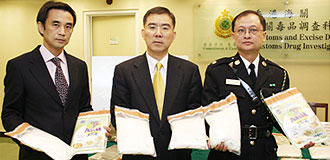 |
| (From
left) Superintendent Mr. C W Lee, Senior Superintendent
Mr. L C Leung and Superintendent Mr. M C Wong
showed the seizure of ketamine in a press conference
in March 2006 |
|
|
In the past, most ketamine reached Hong Kong overland from the
Mainland. However, in 2005, there was a change of smuggling route
from land to air. Trafficking syndicates smuggled ketamine into
Hong Kong from South East Asian countries, in particular Malaysia
and India. About 60 per cent of the 242.1 kilograms ketamine seized
in 2005 were effected at the Hong Kong International Airport, and
94.7 kilograms ketamine were seized in an “Operation Bayonet” initiated
to cope with the change in smuggling route. In 2006, the department
seized 49.2 kilograms ketamine at the Airport which was equivalent
to 86 per cent of the 57.4 kilograms ketamine seized.
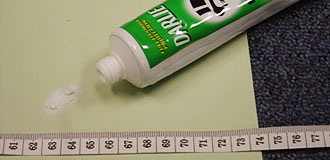 |
| In
May 2005, 2.67 kilograms of ketamine were concealed
inside some foodstuffs and personal hygiene kits
of an incoming Malaysian man at the Hong Kong
International Airport |
|
|
Heroin remained the most common drug of abuse in Hong Kong. The
heroin seized in Hong Kong mainly originated from the Golden Triangle
and was transported overland to the southern part of the Mainland
such as Guangdong or Yunan Provinces for stockpiling. Drug syndicates
usually employed drug couriers and use lorries and private cars
to smuggle heroin in small and frequent consignments into Hong
Kong. Some traffickers concealed the drug inside their body cavities
in order to circumvent detection. In 2005, the department arrested
10 drug couriers with 893.8 grams of heroin seized at the land
boundary crossing points. In 2006 , 7 drug couriers were arrested
with 867.2 grams of heroin seized at the land boundary crossing
points. On the other hand, the department noticed the emerging
source of heroin from ‘Golden Crescent’ (Afghanistan,
Iran and Pakistan) and would continue to put more efforts for combating
heroin trafficking through the airport.
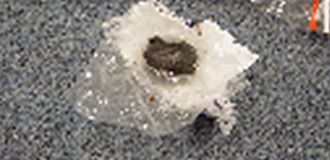 |
| In
April 2006, Customs officers at the Hong Kong
International Airport seized 3.1 kilograms of
heroin concealed inside packets of dried plum
from a Taiwan woman |
|
|
The sources of herbal cannabis found in Hong Kong are commonly
from Cambodia and Thailand. In 2005, a total of 102.8 kilograms
of cannabis were seized with 46 persons arrested. Among these cases,
a storage cum distribution centre was smashed in April in which
officers arrested two local men and seized 77.7 kilograms of herbal
cannabis and some packing paraphernalia. In 2006, 97 kilograms
of herbal cannabis were seized with 27 persons arrested. Among
those cases, there were four passengers arrested with total
85 kilograms herbal cannabis seized from their suitcases at the
airport or Hong Kong-Macao Ferry Terminal.
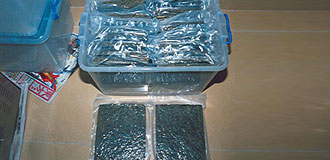 |
| A
storage cum distribution centre of herbal cannabis
was smashed in April 2005 |
|
|
The abuse of cannabis resin is not common in Hong Kong and the
demand in the market is shrinking in recent years. In 2005, there
were total 9.54 kilograms of cannabis resin being seized, whereas
in 2006, 1.3 kilograms were seized.
 |
 |
| Total
45 kilograms of herbal cannabis were found from
2 incoming South African women at the Hong Kong
International Airport on two consecutive days
in August 2006. |
|
|
Methylamphetamine (‘ice’) seized in Hong Kong was
commonly from neighbouring countries and the Mainland, and was
either for local consumption or for small-scale re-export to other
countries. In 2005 and 2006, the department seized 18.5 kilograms
and 555 grams methylamphetamine respectively. In January 2005,
a courier and his escort were arrested at the airport with seizure
of 3.8 kilograms of body-packed methylamphetamine when they were
about to depart for New Zealand. Apart from this case, another
passenger heading for New Zealand was arrested at the airport with
3.6 kilograms of pseudoephedrine, a precursor chemical for methylamphetamine
in the same month. As a result of vigorous enforcement actions
of the department, "ice" smuggling activities have been
quiescent since early 2003.
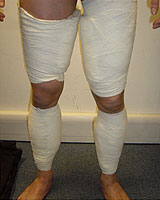 |
A
Hong Kong man packed 1.56 kilograms of methylamphetamine
around his legs and was about to depart for Australia
with a group tour in January 2005. |
|
|
Transnational ‘ice’ traffickers are trending to exploit
tour groups for their wicked business. From 2005 to 2006, 7 local
people were arrested and 17 kilograms of methylamphetamine, body-packed
or concealed in luggage, were seized at the Airport. They all joined
tour groups organized by local travel agencies for destinations
in Japan, Australia or New Zealand.
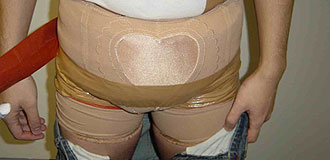 |
| A
Hong Kong man bodily packed 2.6 kilograms of
methylamphetamine and was about to depart for
Japan with a group tour in March 2005. |
|
|
The abuse of "ecstasy", once on a meteoric rise, has
rapidly lost its popularity in the past two years. Other than the
products from Europe, lower quality "ecstasy-type" tablets
produced on the Mainland are commonly found in night entertainment
venues. These "ecstasy-type" tablets contain substances
such as ketamine, "ice" and other additives. In 2005,
the department seized 3 285 tablets of “ecstasy”. In
2006 , the department seized 19 935 tablets and 85 grams of “ecstasy”
Cocaine, originating in South America, is commonly used among
a minority of affluent sector of the community. To circumvent Customs
detection, traffickers have adopted diversionary routes starting
from South American countries to Europe, or the USA or South Africa,
before coming into Hong Kong. Internal concealment method was common
in cocaine trafficking. In 2005 and 2006, the department seized
5.2 kilograms and 9.3 kilograms of cocaine respectively.
In 2006, the department arrested nine couriers of eight different
nationalities at the Hong Kong International Airport for trafficking
a total of 7.2 kilograms of cocaine. Among these, three couriers
concealed pellets of cocaine inside the body cavity. In July, a
Peruvian woman from Brazil via Johannesburg was arrested with 99
plastic pellets of cocaine, weighting 1.4 kilograms, concealed
inside her body cavity. In August, a Peruvian man from Argentina
via Kuala Lumpur was also arrested with 161 plastic pellets of
cocaine, weighting 1.6 kilograms, concealed inside his body cavity.
In September, a Colombian man from Brazil via Johannesburg was
arrested with 50 plastic pellets of cocaine, weighting 743 grams,
concealed inside his body cavity.
|

